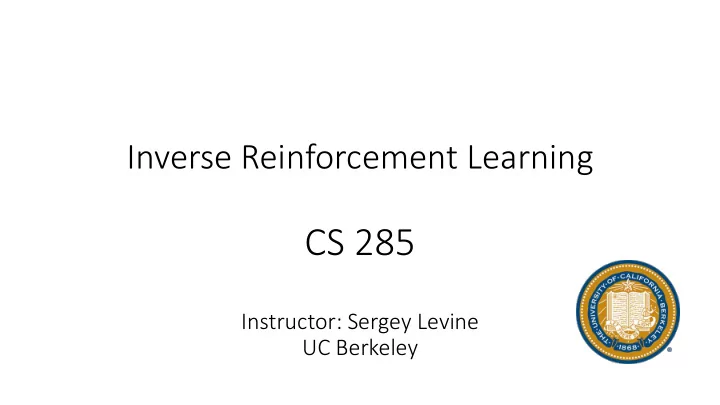

Inverse Reinforcement Learning CS 285 Instructor: Sergey Levine UC Berkeley
Today’s Lecture 1. So far: manually design reward function to define a task 2. What if we want to learn the reward function from observing an expert, and then use reinforcement learning? 3. Apply approximate optimality model from last time, but now learn the reward! • Goals: • Understand the inverse reinforcement learning problem definition • Understand how probabilistic models of behavior can be used to derive inverse reinforcement learning algorithms • Understand a few practical inverse reinforcement learning algorithms we can use
Optimal Control as a Model of Human Behavior Muybridge (c. 1870) Mombaur et al. ‘09 Li & Todorov ‘06 Ziebart ‘08 optimize this to explain the data
Why should we worry about learning rewards? The imitation learning perspective Standard imitation learning: Human imitation learning: • • copy the actions performed by the expert copy the intent of the expert • • no reasoning about outcomes of actions might take very different actions!
Why should we worry about learning rewards? The reinforcement learning perspective what is the reward?
Inverse reinforcement learning Infer reward fu functions from demonstrations by itself, this is an underspecified problem many reward functions can explain the same behavior
A bit more formally “forward” reinforcement learning inverse reinforcement learning reward parameters
Feature matching IRL still ambiguous!
Feature matching IRL & maximum margin Issues: Maximizing the margin is a bit arbitrary • No clear model of expert suboptimality (can add slack variables…) • Messy constrained optimization problem – not great for deep learning! • Further reading: Abbeel & Ng: Apprenticeship learning via inverse reinforcement learning • Ratliff et al: Maximum margin planning •
Optimal Control as a Model of Human Behavior Muybridge (c. 1870) Mombaur et al. ‘09 Li & Todorov ‘06 Ziebart ‘08
A probabilistic graphical model of decision making no assumption of optimal behavior!
Learning the Reward Function
Learning the optimality variable reward parameters
The IRL partition function
Estimating the expectation
Estimating the expectation
The MaxEnt IRL algorithm Why MaxEnt? Ziebart et al. 2008: Maximum Entropy Inverse Reinforcement Learning
Approximations in High Dimensions
What’s missing so far? • MaxEnt IRL so far requires… • Solving for (soft) optimal policy in the inner loop • Enumerating all state-action tuples for visitation frequency and gradient • To apply this in practical problem settings, we need to handle… • Large and continuous state and action spaces • States obtained via sampling only • Unknown dynamics
Unknown dynamics & large state/action spaces Assume we don’t know the dynamics, but we can sample, like in standard RL
More efficient sample-based updates
Importance sampling
guided cost learning algorithm (Finn et al. ICML ’16) policy π generate policy samples from π Update reward using samples & demos update π w.r.t. reward reward r policy π slides adapted from C. Finn
IRL and GANs
It looks a bit like a game… policy π
Generative Adversarial Networks Zhu et al. ‘17 Arjovsky et al. ‘17 Isola et al. ‘17 Goodfellow et al. ‘14
Inverse RL as a GAN Finn*, Christiano* et al. “A Connection Between Generative Adversarial Networks, Inverse Reinforcement Learning, and Energy - Based Models.”
Inverse RL as a GAN Finn*, Christiano* et al. “A Connection Between Generative Adversarial Networks, Inverse Reinforcement Learning, and Energy - Based Models.”
Generalization via inverse RL what can we learn from the demonstration to enable better transfer ? need to decouple the goal from the dynamics ! policy = reward + demonstration reproduce behavior under different conditions dynamics Fu et al. Learning Robust Rewards with Adversarial Inverse Reinforcement Learning
Can we just use a regular discriminator? Pros & cons: + often simpler to set up optimization, fewer moving parts - discriminator knows nothing at convergence - generally cannot reoptimize the “reward” Ho & Ermon. Generative adversarial imitation learning.
IRL as adversarial optimization Guided Cost Learning Generative Adversarial Imitation Learning Finn et al., ICML 2016 Ho & Ermon, NIPS 2016 Hausman, Chebotar, Schaal, Sukhatme, Lim reward function classifier robot attempt robot attempt Peng, Kanazawa, Toyer, Abbeel, Levine actually the same thing!
Suggested Reading on Inverse RL Classic Papers : Abbeel & Ng ICML ’04 . Apprenticeship Learning via Inverse Reinforcement Learning. Good introduction to inverse reinforcement learning Ziebart et al. AAAI ’08. Maximum Entropy Inverse Reinforcement Learning. Introduction to probabilistic method for inverse reinforcement learning Modern Papers : Finn et al. ICML ’16. Guided Cost Learning. Sampling based method for MaxEnt IRL that handles unknown dynamics and deep reward functions Wulfmeier et al. arXiv ’16 . Deep Maximum Entropy Inverse Reinforcement Learning. MaxEnt inverse RL using deep reward functions Ho & Ermon NIPS ’16. Generative Adversarial Imitation Learning. Inverse RL method using generative adversarial networks Fu, Luo, Levine ICLR ‘18. Learning Robust Rewards with Adversarial Inverse Reinforcement Learning
Recommend
More recommend